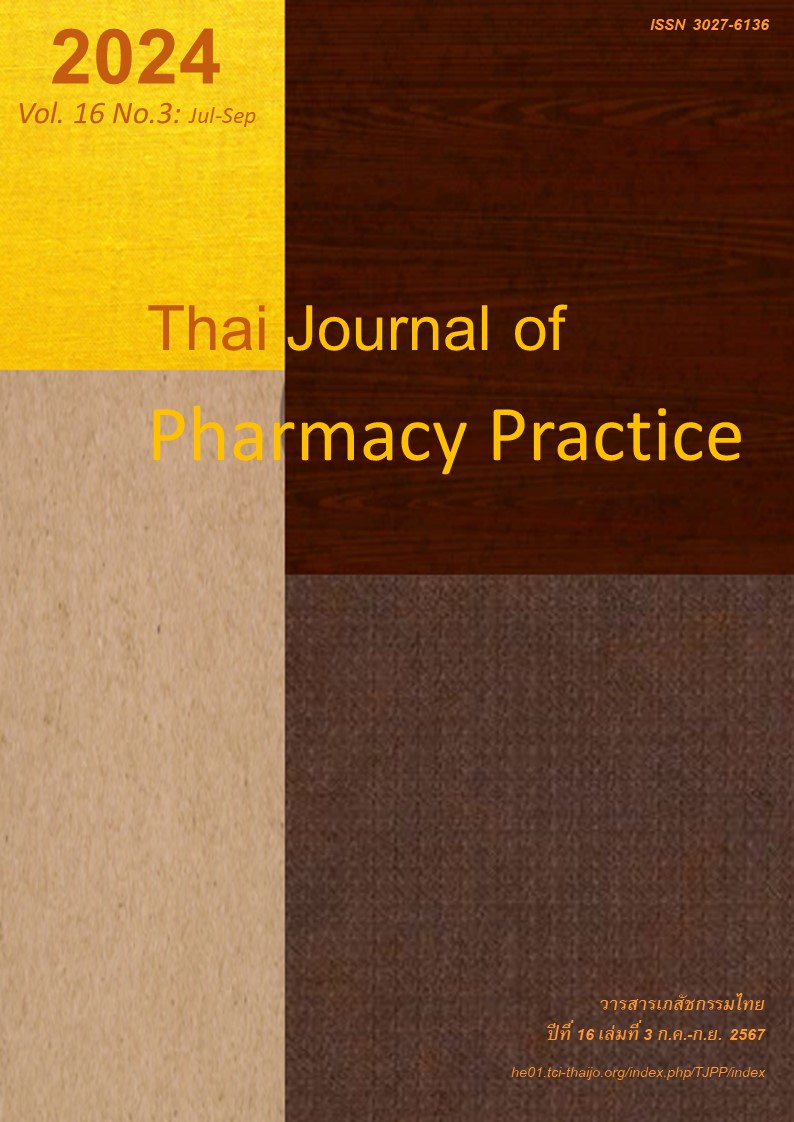ผลการดำเนินงานของเครือข่ายการใช้ยาอย่างสมเหตุผลในชุมชนด้วยการวิจัยเชิงปฏิบัติการ แบบมีส่วนร่วม: กรณีศึกษาการใช้ยาปฏิชีวนะและยาต้านอักเสบชนิดไม่ใช่สเตียรอยด์อย่างสมเหตุผล
Main Article Content
บทคัดย่อ
วัตถุประสงค์: เพื่อสร้างเครือข่ายการใช้ยาอย่างสมเหตุผลในชุมชน (rational drug use community: RDU community) เพื่อส่งเสริมการใช้ยาอย่างสมเหตุผลในตำบลไทรน้อย อำเภอบางบาล จังหวัดพระนครศรีอยุธยา โดยใช้การวิจัยเชิงปฏิบัติการแบบมีส่วนร่วม (participatory action research: PAR) วิธีการ: การศึกษาใช้ PAR ในการสร้างเครือข่าย RDU community ซึ่งมี 5 ขั้นตอน ได้แก่ การสังเกต การสะท้อนความคิด การวางแผน การลงมือปฏิบัติ และการแลกเปลี่ยน การศึกษาประเมินผลการดำเนินงานของเครือข่ายฯ ในตัวอย่างประชาชนในตำบลไทรน้อย 133 คน โดยใช้แบบสอบถามวัดความรู้ ทัศนคติเกี่ยวกับการใช้ยาปฏิชีวนะและยาต้านอักเสบชนิดไม่ใช่สเตียรอยด์ (non-steroidal anti-inflammatory drugs: NSAIDs) ก่อนและหลังการดำเนินงานของเครือข่ายฯ เป็นเวลา 8 เดือน ระหว่าง มีนาคม – ตุลาคม 2565 ผลการวิจัย: การจัดตั้งเครือข่าย RDU community เป็นไปตามแนวคิดของชุมชนเพื่อแก้ไขปัญหาการใช้ยาปฏิชีวนะและ NSAIDs โดยให้สมาชิกที่เป็นอาสาสมัครสาธารณสุขประจำหมู่บ้าน (อสม.) จำนวน 40 คนดำเนินการให้ความรู้แก่กลุ่มตัวอย่าง 133 ราย หลังเสร็จสิ้นโครงการพบว่า กลุ่มตัวอย่างมีค่าเฉลี่ยความรู้เกี่ยวกับการใช้ยาปฏิชีวนะอย่างสมเหตุผลเพิ่มขึ้น จาก 5.68 ±2.05 เป็น 8.95 ±1.34 (คะแนนเต็ม 10: P<0.001) ค่าเฉลี่ยความรู้เกี่ยวกับยา NSAIDs เพิ่มขึ้นจาก 5.27 ±2.49 เป็น 9.02 ±1.24 (คะแนนเต็ม 10: P<0.001) การเปรียบเทียบความรู้เกี่ยวกับการใช้ยาปฏิชีวนะและยา NSAIDs หลังอบรมในแต่ละข้อคำถามเมื่อเทียบกับก่อนอบรม พบว่าเพิ่มขึ้นอย่างมีนัยสำคัญทางสถิติที่ระดับ 0.05 หลังการอบรม คำถามแต่ละข้อมีผู้ตอบถูกมากกว่าร้อยละ 70 ทัศนคติเกี่ยวกับการใช้ยาอย่างสมเหตุผลดีขึ้น โดยจำนวนตัวอย่างที่เห็นด้วยและเห็นด้วยอย่างยิ่งต่อการใช้ยาสมเหตุผลมีจำนวนเพิ่มขึ้นหลังการอบรม สรุป: เครือข่าย RDU community ที่จัดตั้งโดยสมาชิกในชุมชนและมี อสม. เป็นแกนนำสามารถเสริมสร้างความรู้และทัศนคติเกี่ยวกับการใช้ยาอย่างสมเหตุผลให้แก่กลุ่มเป้าหมายให้เพิ่มขึ้นได้ ดังนั้นจึงควรพัฒนาการดำเนินงานของเครือข่ายเพื่อส่งเสริมการใช้ยาอย่างสมเหตุผลอย่างยั่งยืน
Article Details

อนุญาตภายใต้เงื่อนไข Creative Commons Attribution-NonCommercial-NoDerivatives 4.0 International License.
ผลการวิจัยและความคิดเห็นที่ปรากฏในบทความถือเป็นความคิดเห็นและอยู่ในความรับผิดชอบของผู้นิพนธ์ มิใช่ความเห็นหรือความรับผิดชอบของกองบรรณาธิการ หรือคณะเภสัชศาสตร์ มหาวิทยาลัยสงขลานครินทร์ ทั้งนี้ไม่รวมความผิดพลาดอันเกิดจากการพิมพ์ บทความที่ได้รับการเผยแพร่โดยวารสารเภสัชกรรมไทยถือเป็นสิทธิ์ของวารสารฯ
เอกสารอ้างอิง
Phosiri P. Promoting good governance in the context of rational drug use [online]. 2017 [cited Nov 11, 2018]. Available from: dmsic.moph.go.th/dmsic/ad min/files/userfiles/files/D1_S1_Pakdee.pdf
Public Health Administration Division, Office of the Permanent Secretary, Ministry of Public Health. Rational drug use community: RDU community [online]. 2016 [cited Arp 21, 2023]. Available drive. google.com/file/d/1giRjkFryOdGFdWmmYup_DFSZZTJF_UcK/view
Ampansirirat A., Wongchaiya P. Participatory action research: Key characteristics and applications in community. Journal of Humanities and Social Sciences Mahasarakham University 2017; 6: 192-202
Intolo S. Participation of network partners in caring for the elderly in the community. Maha Sarakham: Social Welfare Fund, Office of Social Development and Human Security, Maha Sarakham Province, Ministry of Social Development and Human Security; 2009.
Cochran WG. Sampling techniques. 3 rd Ed. New York: John Wiley & Sons; 1977.
Cohen J. Statistical power analysis for the behavioral sciences. 2nd Ed. Hillsdale, New Jersey: Lawrence Erlbaum Associates; 1988
Ruenruay S. Management of drugs and health product related problems in communities via the network of home, temple, school and hospital. Thai Journal of Pharmacy Practice 2020; 12: 855-68.
Angkanavisul T. Musikachai P. Lessons learned from the project on drug safety management within community by engaging the network of partners in Phra Nakhon Si Ayutthaya during 2015-2017. Thai Journal of Pharmacy Practice 2018; 10: 142-60.
Division of Health Education. Networking and participation in community health behavior change [online]. 2023 [cited Mar 31, 2023]. Available from: www.hed.go.th/news/8592.
Narkmit C. Prevalence, knowledge, attitude and behavior of rational uses of antibiotics and steroid-adulterated health products among the elderly in Suratthani province. Thai Bulletin of Pharmaceutical Sciences 2020; 15: 81-94.


